

Original Article - Year 2014 - Volume 29 -
Estudo de complicações em próteses mamárias: avaliação de 546 casos em oito anos
A report on complications of breast implantation: evaluation of 546 cases in 8 years
RESUMO
INTRODUÇÃO: O implante de próteses mamárias é uma das cirurgias mais frequentes e desafiadoras da cirurgia plástica, devido às complicações associadas.
MÉTODO: Foi realizado um estudo retrospectivo de 546 pacientes operadas em oito anos (maio de 2004 a maio de 2012), sendo estudadas todas as pacientes submetidas à inclusão de próteses mamárias, isoladamente ou associadas à mastopexia ou mamoplastia redutora.
RESULTADOS: Foram utilizadas próteses texturizadas em 84,8% e poliuretano, em 15,2%, com plano de implantação subglandular em 91,7% e submuscular, em 8,24%. Foram estudados: contratura (3,3%), seroma (2,7%), ptose (2,7%) e infecção (0,6%). A maioria das contraturas surgiu cinco anos após a cirurgia e apenas nas próteses texturizadas, que tiveram tempo de seguimento maior (4,2 anos, nas próteses texturizadas versus 1,7 ano nas de poliuretano). Houve maior frequencia de ptose nas texturizadas e de infecção, nas de poliuretano. Somente apresentaram contraturas pacientes com próteses texturizadas no período observado. Comparando-se o plano de implantação, o seroma foi mais frequente nas submusculares. Considerando-se a complexidade do procedimento, houve aumento do índice de complicações: nas implantadas com poliuretano, aumentou o índice de infecção; nas texturizadas, de ptose e seroma, mas não houve diferenças quanto à contratura. Todos os casos de infecção ocorreram em mamoplastias redutoras com próteses de poliuretano e foram causados por germes comuns, sem casos de micobactérias.
CONCLUSÕES: Contraturas e ptose foram exclusivas em próteses texturizadas, no tempo de seguimento mais curto. Infecção apenas ocorreu em próteses de poliuretano. As mastopexias e mamoplastias redutoras apresentaram um índice progressivamente mais alto de complicações.
Palavras-chave: Implante mamário; Poliuretanos; Contratura capsular de implantes; Seroma.
ABSTRACT
INTRODUCTION: Breast augmentation implant surgery is one of the most frequently performed plastic surgery procedures; however, it can be challenging because of its associated complications.
METHOD: We conducted a retrospective study of 546 patients operated on in eight years (May 2004 to May 2012). These patients underwent breast augmentation, alone or in association with mastopexy or breast reduction.
RESULTS: In this study, 84.8% textured and 15.2% polyurethane prostheses, with 91.7% deployed in the subglandular plane and 8.24% in the submuscular plane, were used. We investigated the occurrence of contracture (3.3%), seroma (2.7%), ptosis (2.7%), and infection (0.6%). Most contractures occurred 5 years after surgery and only in textured prostheses, which had a longer follow-up (4.2 years for textured implants vs. 1.7 years for polyurethane implants). There was a higher frequency of ptosis in textured implants and of infection in polyurethane implants. Only patients with textured prostheses showed contractures in the observed period. Concerning the deployment plane, seroma was more frequently observed in submuscular implants. More complex procedures showed a higher rate of complications. Polyurethane implants were associated with increased infection rates, whereas textured implants resulted in ptosis and seroma; however, there were no differences in contracture rates. All cases of infection occurred in patients who received reduction mammoplasty with polyurethane prostheses and were caused by common germs, with no cases of mycobacterial infection.
CONCLUSIONS: Contractures and ptosis uniquely occurred in textured prostheses in the shortest follow-up time. Infection occurred only in polyurethane prostheses. Mastopexies and reduction mammoplasties showed a progressively higher rate of complications.
Keywords: Breast implant; Polyurethanes; Capsular contracture of implants; Seroma.
As mamas representam o órgão da feminilidade por excelência, o que reveste de grande importância sua melhoria estética. Deste modo, o implante de próteses mamárias é uma das cirurgias mais realizadas no Brasil e no mundo.
Desde os idos de 1889, quando os primeiros e malfadados aumentos de mama foram realizados com substâncias de preenchimento, muito se criou e muito se aprimorou. As primeiras próteses de silicone foram introduzidas em 1962 e, com estas, vieram os primeiros desafios: altos índices de contratura capsular e ruptura, parcialmente melhorados com os revestimentos texturizados e de poliuretano. Rumores de aumento da incidência de câncer e doenças autoimunes levaram à interrupção temporária de sua comercialização nos Estados Unidos, sendo liberados após extensos estudos.
As opções de implantes são várias e muito se discute acerca do melhor posicionamento, subglandular ou submuscular, e da realização concomitante de mastopexia e inclusão da prótese. Mesmo assim, a reoperação chega a ocorrer em 24% das pacientes1-3. O estudo de suas causas é de vital importância para nos auxiliar no aprimoramento de nossos resultados. A contratura quase sempre é sua maior causa e tem índices bastante heterogêneos na literatura, entre 0,86 e 58%1,3-6. A infecção ocorre em 1,7 a 2,8%1,4, e é bastante relevante, pois normalmente determina a retirada da prótese, fato de grande repercussão psicológica para a paciente. Os seromas têm sido estudados amplamente com relação ao fator causal, ainda sem conclusões. Além disso, tem se discutido acerca do linfoma anaplásico de grandes células, causa rara de seromas tardios, que não pode ser negligenciada7-9.
A mastopexia com inclusão de próteses é um conceito antigo e ainda muito questionado, pois aumenta a incidência de complicações, trazendo, contudo, os benefícios da realização de procedimento único2,10. Já a mamoplastia redutora com uso de próteses é mais recente e com menor número de adeptos, criticada pelo paradoxo de substituir o tecido mamário por uma prótese. Entretanto, o pobre preenchimento do colo nas mamoplastias redutoras tem favorecido a disseminação deste conceito11,12, enquanto o aumento das complicações ainda está por ser apreciado.
O presente estudo visa avaliar a incidência de complicações nas cirurgias de próteses mamárias isoladas ou associadas a mastopexia e mamoplastia redutora, numa experiência pessoal de 546 casos operados em oito anos.
MÉTODOS
Foi realizado um estudo retrospectivo de 546 pacientes consecutivas, operadas de maio de 2004 a maio de 2012, através da análise de prontuários. Todas foram operadas pela mesma cirurgiã, em clínica privada.
Foram estudadas todas as pacientes submetidas à inclusão de próteses mamárias, isoladamente ou associadas à mastopexia ou à mamoplastia redutora. Para a mamoplastia redutora com uso de prótese, foram selecionadas pacientes que apresentavam tecido mamário predominantemente gorduroso, em que a prótese funcionaria como material de melhora da consistência do tecido. A finalidade do implante, neste caso, não foi a de aumento, de modo que utilizamos um volume implantado menor que o ressecado.
Técnica cirúrgica
O volume das próteses foi estimado em consulta pré-operatória, através da avaliação dos provadores.
O posicionamento subglandular ou submuscular foi determinado pela quantidade estimada de tecido mamário ao pinçamento bidigital: em espessuras menores de 2 cm no polo superior, foi utilizado o plano submuscular; nas demais, subglandular.
Todas as pacientes foram operadas sob anestesia peridural torácica e sedação. Realiza-se a antissepsia com clorexidina degermante seguida de clorexidina alcoólica.
Nas cirurgias de simples inclusão, foram utilizadas as incisões inframamária e periareolar inferior. A incisão inframamária foi posicionada no nível do futuro sulco mamário e teve uma extensão de 4 cm. Foi dissecado o espaço subglandular ou submuscular em plano duplo. Neste caso, realizamos a secção completa da inserção medial do músculo peitoral maior na margem esternal até o quarto espaço intercostal, para diminuir a mobilização superior da prótese promovida pelo músculo, preservando o prolongamento fascial que conecta o músculo à caixa torácica, minimizando o deslocamento inferior do implante.
Nos casos de mastopexia, após marcação do ponto A e cicatriz periareolar e vertical, a mama é incisada verticalmente para abordar o plano subglandular ou submuscular. A prótese é incluída e o excesso de pele é ressecado na vertical, com compensação horizontal.
A redução mamária foi realizada segundo Princípios de Pitanguy12. Após a incisão, resseca-se o polo inferior e uma quilha retroareolar correspondente ao volume que se deseja retirar. Em casos de assimetria mamária, resseca-se um maior volume do lado maior na tentativa de equilibrá-los e permitir a utilização de próteses de mesmo volume, sempre que possível.
As luvas são trocadas e incluídas as próteses com revestimento texturizado ou de poliuretano Silimed®. Nenhuma solução é aplicada à prótese ou à sua loja. Não utilizamos drenos. É realizado o fechamento do tecido mamário e da pele. Realizamos antibioticoprofilaxia com Cefazolina e medidas profiláticas de Tromboembolismo Venoso.
As pacientes são acompanhadas ambulatorialmente por um ano, quando recebem recomendações, pela própria cirurgiã, de retornar em caso de aumento de volume das mamas ou seu endurecimento.
RESULTADOS
Um total de 546 pacientes foi operado, de maio de 2004 a maio de 2012. Suas idades variaram entre 16 e 65 anos, média de 32,4 anos (desvio padrão= 9,8 anos). O volume de inclusão médio foi de 310 mL nas inclusões simples e 255 mL, nas mastopexias. Nas mamoplastias redutoras, foi retirada uma média de 309 g de tecido mamário (de 160 g a 447 g) e incluído, em média, um volume de 225 mL (Tabela 1).
Foi realizada análise estatística das complicações mais encontradas: contratura, seroma e ptose (Tabela 2). Ptose foi definida como deslocamento inferior do implante. Foi também incluído o estudo de infecção, dada sua relevância clínica.
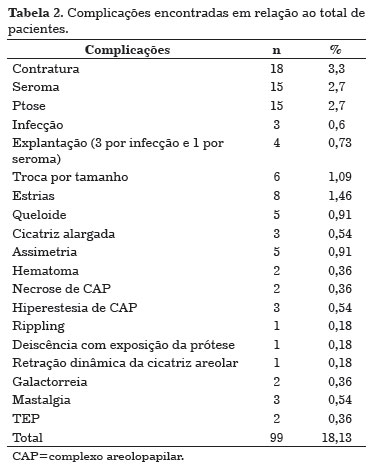
Os dados obtidos foram tabulados em planilhas do software Excel® (2003). A avaliação das variáveis foi realizada pelo software BioEstat® (versão 3.0). Adotou-se um intervalo de confiança de 95% e valor de p<0,05.
Na Tabela 3, podemos observar que, entre as complicações, houve diferença estatística significativa para contratura, ptose e infecção.
Para contratura e ptose, houve maior incidência nas próteses texturizadas em relação às de poliuretano, no período observado, sendo esta diferença estatisticamente significante.
Entre as pacientes com seroma, não houve diferença estatística entre texturizadas e de poliuretano.
Quanto à frequência de infecção, foi maior com poliuretano do que texturizada.
Na Tabela 4, considerando-se a frequência geral de complicações, esta foi maior nas submusculares (15,55%) que nas subglandulares (8,38%).
Apenas no grupo do seroma foi observada diferença estatisticamente significativa, sendo maior nas submusculares.
Quanto à infecção, não foi observada diferença estatisticamente significativa entre os dois locais de implantação, mesmo que todas as ocorrências de infecção tenham sido observadas na implantação subglandular.
Não houve diferença estatística entre contratura e ptose, no período observado. Entretanto, a contratura quase foi significativa, sendo mais frequente nas submusculares.
Na Tabela 5, nas pacientes implantadas com próteses texturizadas, podemos notar que os grupos ptose e seroma apresentaram diferença estatisticamente significativa, tendo sido mais frequentes nas mamoplastias associadas a implantes texturizados.
Das pacientes com seroma, foram encontrados índices semelhantes entre simples inclusão e mastopexia, mas a incidência aumentou significativamente nas mamoplastias redutoras.
Na avaliação da ptose, o aumento da complexidade do procedimento também aumentou sua frequência estatística.
Com relação à contratura, não foi observada diferença significativa entre as pacientes com próteses texturizadas nas diversas técnicas.
Não foi observada infecção no grupo das próteses texturizadas.
Na Tabela 6, nas pacientes implantadas com próteses de poliuretano, não houve diferença estatística significativa entre todas as complicações e o tipo de inclusão realizada. Porém, é importante ressaltar que todos os casos de infecção apareceram no grupo de próteses de poliuretano e foram progressivamente mais frequentes, de acordo com a complexidade do procedimento; entretanto, a análise estatística não comprovou tal fato.
Na Tabela 7, houve diferença estatisticamente significativa quanto ao tempo de seguimento de cada grupo. As pacientes que foram submetidas ao implante texturizado apresentaram uma média de seguimento de 4,2 anos, contrastando com 1,7 ano nas que receberam poliuretano.

Segundo o Gráfico 1, metade das pacientes que apresentou seroma o fez em até 45 dias após a cirurgia, sendo a maioria nos primeiros 20 dias. Das que apresentaram seromas tardios, três delas o fizeram após o aleitamento.
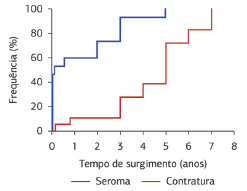
Gráfico 1. Tempo de surgimento de contratura e seroma.
Foram bastante raras as contraturas no primeiro ano (0,36%); a maioria aconteceu cerca de cinco anos após a cirurgia.
DISCUSSÃO
As próteses de mama foram introduzidas em 1962 por Cronin e Gerow, e desde então foram muitas vezes aperfeiçoadas. O alto índice inicial de contratura capsular com as próteses lisas foi diminuído pelo revestimento texturizado e, posteriormente, pelo poliuretano13. As rupturas, causadas geralmente pela dissolução do envoltório pelo próprio silicone, também têm diminuído, devido ao seu maior reforço.
O revestimento de poliuretano foi introduzido por Ashley, como alternativa menos causadora de contratura capsular5, pois leva à ocorrência de uma resposta celular que conduz à formação de uma cápsula com padrão não linear de fibrose, que não produz uma cápsula esférica deformante, além de aderir ao tecido mamário. Sua degradação química gerando toluenodiamina (2-4TDA), produto carcinogênico, foi alvo de amplas investigações. Os estudos que encontraram tal subproduto na urina foram realizados em ratos e não foram reprodutíveis em humanos. O Safety Panel de 1991 concluiu que se tratava de material seguro14 e, em 1995, sua comercialização foi liberada pelo Food and Drug Administration (FDA).
Paralelamente à concordância geral de que o poliuretano minimiza a contratura capsular, alguns autores mostram sua degradação, que estaria relacionada ao aparecimento de contraturas tardias. O maior estudo do gênero analisou 75 próteses explantadas e concluiu que não há poliuretano detectável após três anos de implante, principalmente em casos de contratura e infecção15. Na experiência pessoal da autora, houve dois casos de troca de prótese de poliuretano, após cinco anos, em que poliuretano íntegro foi encontrado, mostrando inclusive boa aderência ao tecido mamário.
No presente estudo, avaliando-se texturizadas versus poliuretano, houve maior frequência de contratura e ptose nas texturizadas, no período observado, não havendo diferença com relação ao seroma. Um fato bastante relevante é que não foi encontrada contratura nas próteses de poliuretano; contudo, seu tempo de seguimento foi menor (1,7 ano nas de poliuretano versus 4,2 anos nas texturizadas). Considerando-se que a maioria das contraturas ocorreu após cinco anos de implantação, este tempo de seguimento pode ter prejudicado a avaliação.
Apenas apresentaram ptose as pacientes implantadas com texturizadas, neste período observado. São fartos os relatos do "efeito velcro" do poliuretano, que fixaria melhor o tecido mamário à parede torácica, mas este fato carece de comprovação científica.
A mamoplastia redutora com o uso de próteses tem sido realizada por alguns no intuito de aperfeiçoar os resultados, muitas vezes comprometidos por falta de consistência das mamas e pobre preenchimento do colo, quando não é utilizada uma prótese. Além disso, os resultados são mais duradouros, pois os efeitos da lipossubstituição glandular são compensados pela presença do implante, que mantém o formato arredondado da mama, ainda que apresente ptose. O aparente paradoxo de colocar uma prótese numa cirurgia de redução de mama deve ser entendido como uma soma de fatores positivos de cada técnica11.
Este conceito foi introduzido por Gonzalez-Ulloa, em 19602. Baroudi, pioneiro de sua realização no Brasil, mostrou, em 1976, que a inclusão de prótese associada à mastopexia era uma cirurgia segura e de bons resultados, uma vez que a correção da ptose com a simples mastopexia muitas vezes produz um bom posicionamento da glândula com falta de volume; por outro lado, a simples inclusão da prótese numa mama ptótica traz um resultado inestético pelo mau posicionamento do CAP10. A despeito de ser criticada por muitos pelo aumento do índice de complicações, mostra vantagens, como uma intervenção única, menores custos e riscos, e menor tempo de afastamento das atividades cotidianas. Um estudo de 332 casos encontrou um índice de complicações um pouco mais alto, mas apenas aditivo diante da realização de dois procedimentos2.
Nas comparações de simples inclusões, mastopexias e mamoplastias redutoras, no grupo das texturizadas, houve diferença estatística para ptose e seroma. A ptose foi progressivamente maior com o aumento da complexidade do procedimento, provavelmente devida ao fato de a ptose prévia sugerir pacientes de pele mais frágil. O seroma foi semelhante nas simples inclusões e mastopexias, mas consideravelmente mais frequente nas mamoplastias redutoras.
Já no grupo do poliuretano, a despeito de não ter sido encontrada diferença estatisticamente significativa, todos os casos de infecção ocorreram neste grupo, e sua incidência foi progressivamente maior com o aumento da complexidade do procedimento. Todos os casos de necrose de CAP ocorreram em mamoplastias redutoras com próteses de poliuretano. Trata-se de complicações pouco frequentes, mas de grande relevância. A confrontação estatística destes dados é bastante difícil, em virtude da não ocorrência em todos os grupos estudados e da amostragem insuficiente.
A contratura capsular figura sempre como a causa mais comum de reoperação para troca de prótese (Figura 1). Sua graduação de 1 a 4 é definida segundo critérios de Baker16. Sua ocorrência é bastante heterogênea na literatura, oscilando entre 0,86 e 58%1,3-6, atribuíveis principalmente a critérios de seguimento: quanto mais longo e rigoroso, maiores são as incidências. Um estudo de 812 pacientes operadas, em 15 anos, mostra um índice de contratura Baker 3 ou 4, de 8,2%, em 6 anos, com próteses salinas e de silicone1. Um estudo prospectivo, de 5.373 mulheres operadas por um grupo de cirurgiões em oito anos, mostra um índice de contratura Baker 3 ou 4, de 1,2%, em três anos, e 1,7%, em cinco anos, mas com seguimento apenas diante da demanda da paciente3. Outro estudo de 752 pacientes, com seguimento de 27 meses, encontrou contratura em 8%, sendo maior nas texturizadas; note-se que a ocorrência de hematoma dobrou o risco de contratura4.
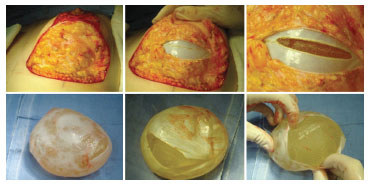
Figura 1. Paciente de 33 anos, submetida havia cinco anos à inclusão de prótese texturizada subglandular periareolar. Um ano após amamentação, apresentou contratura Baker 4, bilateral. Durante a troca da prótese, achada cápsula dupla bastante particular: dentro de uma cápsula fina e aparentemente normal, encontramos outra esférica aderida à prótese, e este conjunto encontrava-se solto dentro da primeira cápsula. A paciente tinha amamentado e suas queixas de endurecimento das mamas começaram pouco depois. Possivelmente, apresentou seroma despercebido durante o aleitamento, que se organizou nesta segunda cápsula deformante. Submetida à capsulectomia com troca por poliuretano, com boa evolução.
Os índices relatados costumam ser menores com o poliuretano, mas este fato também é controverso. Miró encontrou 0,86% de 350 casos6. Num estudo de 294 pacientes implantadas com poliuretano e acompanhadas por 19 anos, houve incidência progressiva de contratura desde 28%, em cinco anos, até 58%, em 15 anos, com pacientes sistematicamente acompanhadas. Atribui-se o aumento da incidência à biodegradação do poliuretano5.
Um estudo de 227 pacientes com contraturas tratadas por troca por poliuretano sugere que 90% das pacientes podem esperar boa consistência das mamas até a segunda década. Enfatiza a necessidade de capsulectomia para promover o contato do poliuretano com o tecido cruento e provocar sua adesão, evitando contraturas17.
Bozola e cols. avaliaram 759 pacientes com próteses de poliuretano em dez anos e não encontraram contraturas que necessitassem de cirurgia12.
No presente estudo, foi encontrada uma frequência de contraturas Baker 3 e 4, de 3,3%, sendo de 3,9% dentre as texturizadas e zero, nas de poliuretano, no período observado. Apenas duas pacientes a apresentaram no primeiro ano, tendo a maioria delas relatado tal ocorrência após cinco anos. A despeito dos relatos de aumento de incidência de contratura após hematoma, nenhuma das pacientes deste estudo a apresentou, mesmo após um seguimento de três e quatro anos. Uma possível razão seria o fato de que foram imediatamente reoperadas, com retirada dos coágulos e lavagem da loja do implante.
Outra complicação bastante prevalente na literatura é o seroma (Figura 2), cuja etiologia permanece incerta. Uma das teorias mais aceitas seria a etiologia infecciosa, mas nem sempre são cultivados microrganismos neste líquido. Além disso, discute-se por qual motivo o biofilme infeccioso, ainda que presente, se manifestaria tão tardiamente, muitas vezes mais de dois anos após a cirurgia. Num estudo de 27 anos, com próteses lisas, texturizadas, de Biocell® e poliuretano, encontraram-se seromas tardios e cápsulas duplas, como achado incidental intraoperatório, apenas com Biocell®, e discute-se o possível efeito mecânico de "tosquia" da cápsula já formada nos seromas tardios18.
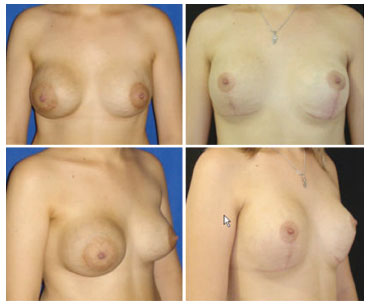
Figura 2. Paciente de 22 anos, após três anos de inclusão de prótese texturizada subglandular, encontrava-se amamentando, quando apresentou seroma; punção guiada por ultrassonografia obteve 320 mL de líquido citrino com cultura negativa. Tratada com betametasona de depósito. Após um mês, novo seroma, com cultura positiva para Staphilococcus aureus, sensível a ciprofloxacino, tratada por 21 dias, com melhora. Após dois meses, houve recidiva e foi indicada cirurgia. Achada cápsula muito espessa, friável, calcificada, com conteúdo gelatinoso e fibrina aderida, fatos que causaram grande dúvida na reimplantação da prótese. Uma vez que a paciente apresentava ausência de quadro clínico infeccioso, bem como provas de atividade inflamatória negativas, decidiu-se pela capsulectomia e pela troca para plano submuscular, com reimplantação da prótese e boa evolução há um ano e meio.
No presente estudo, 2,4% das pacientes apresentaram seroma. Não houve diferenças entre texturizadas e poliuretano, mas foi mais frequente nas submusculares. Com relação à complexidade do procedimento, apenas apresentaram incidência maior as mamoplastias redutoras com próteses texturizadas, fato não encontrado com poliuretano. Além disso, houve dois achados incidentais intraoperatórios de cápsulas duplas, ambas com texturizadas.
Um objeto de estudo recente é a relação entre próteses mamárias e o surgimento do linfoma anaplásico de grandes células, tumor raro associado à ocorrência de seromas tardios. Autores conceituados têm recomendado sistematicamente a citologia oncótica do líquido7-9. Tebbets propõe um algoritmo frente ao seroma tardio. Ressalta a necessidade da realização de punção e análises bacteriológicas e citológicas. Sugere prolongar a observação do meio de cultura, uma vez que seriam germes de baixa virulência e crescimento lento. Espessamento da cápsula, nódulos e/ou citologia oncótica positiva indicariam a necessidade de capsulectomia com retirada dos implantes, até esclarecimento do quadro.
A infecção na loja do implante quase sempre exige a retirada da prótese, numa cirurgia com expectativas tão grandes. Encontramos taxas em torno de 1,7 a 2,8%1,4. A flora endógena da mama inclui estafilococos, difteroides, estreptococos e enterococos, sendo os primeiros os mais causadores de infecção. Estudos sugerem aumento da incidência de infecção com próteses de poliuretano e das texturizadas em relação às lisas, devido à maior superfície das rugosidades e dos microporos do poliuretano, que facilitariam a aderência bacteriana. A presença dos corpos estranhos potencializa infecções: onde não há biomateriais, o inóculo necessário para causar infecção é de um milhão de microrganismos; na sua presença, bastam 100 bactérias19.
No presente estudo, encontramos uma incidência de infecção abaixo dos dados da literatura, considerando-se o total de pacientes (0,54%), mas um nível bem acima dos relatos com poliuretano (3,61%), uma vez que só ocorreram infecções com este material. Este é um dado particularmente relevante que poderia corroborar a teoria acima, porém o tamanho da amostra impede uma conclusão definitiva. Os agentes foram comuns e as pesquisas de BAAR, negativas. Numa infecção após sete meses (Figura 3), foi cogitado falso negativo para micobactérias, mas a paciente evoluiu bem após antibioticoterapia convencional.
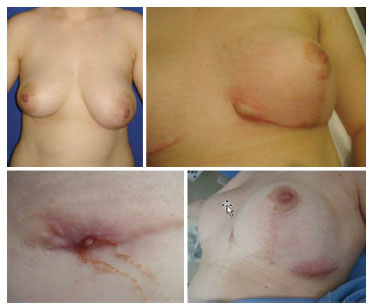
Figura 3. Paciente de 25 anos, submetida à mamoplastia redutora, com inclusão de próteses poliuretano advance. Evoluiu com seroma no pós-operatório imediato, tratado clinicamente. Após sete meses, apresentou abscesso em cicatriz medial de mama esquerda. A ultrassonografia mostrou coleção em contato com a prótese, sem líquido periprótese. Drenado material piossanguinolento, com cultura positiva para Klebsiella pneumoniae, sensível ao ciprofloxacino, e negativa para BAAR. Tentativas de tratamento clínico por três semanas não foram bem sucedidas e a prótese foi retirada, com boa evolução.
A conduta mais aceita quando existem evidências francas de infecção é a retirada do implante, a antibioticoterapia e uma latência de 4 a 6 meses antes da inclusão de uma nova prótese, o que foi efetuado com bons resultados. Há relato de dois casos bem sucedidos submetidos à lavagem da loja e à troca imediata dos implantes, associadas à antibioticoterapia20.
Outra complicação rara de importante repercussão é a necrose do CAP (Figura 4). Está relacionada a deficiências de perfusão sanguínea ou compressão excessiva. Há referências de necroses parciais em 1,2% e nenhum caso de necrose total2. No presente estudo, ambos os casos (0,36%) ocorreram com implantes cônicos de poliuretano, em mamoplastias redutoras com próteses subglandulares. Uma possível causa seria a desvascularização do CAP na confecção da loja do implante, somada às manobras para sua ascensão. O poliuretano adere ao tecido mamário, dificultando o deslizamento dos pilares ao fechar a coluna; além disso, o perfil cônico preenche mais o envelope cutâneo, o que diminui a área de pele a ser ressecada. Este fato deve ser rigorosamente considerado pelos cirurgiões que começam a utilizar este tipo de implante. Sua inobservância pode dificultar o fechamento da pele, levando a retrações, deiscências e necroses. Um caso de necrose parcial foi conduzido com ressutura (Figura 4), mas outro, de necrose total, necessitou sua completa reconstrução, com prolongamento significativo do tempo de recuperação.
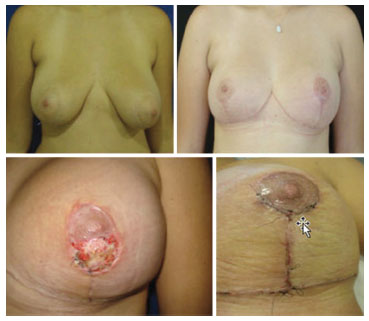
Figura 4. Paciente de 17 anos, submetida à mamoplastia redutora, com inclusão de prótese poliuretano advance. Evoluiu com necrose parcial do CAP à esquerda, tratada com desbridamento e ressutura após 15 dias, com boa evolução.
CONCLUSÕES
Conclui-se que, comparando-se próteses texturizadas versus poliuretano, houve maior frequência de contratura e ptose nas texturizadas, no período observado. A ausência de contratura com poliuretano possivelmente foi relacionada ao tempo de seguimento mais curto. Um dado bastante claro e relevante foi a infecção, que apenas ocorreu com poliuretano.
O plano de implantação afetou negativamente apenas a incidência de seroma, que foi maior nas lojas submusculares.
O aumento da complexidade do procedimento foi deletério nas próteses texturizadas, em que a ptose e o seroma foram progressivamente mais encontrados nos grupos de mastopexia e mamoplastia redutora. Nas próteses de poliuretano, a infecção foi progressivamente mais incidente nos grupos de maior complexidade, apesar de não haver comprovação estatística. A necrose de CAP ocorreu exclusivamente em mamoplastias redutoras com próteses de poliuretano.
Uma limitação deste estudo foi o tempo de seguimento das pacientes, que não foram sistematicamente convocadas, mas apenas orientadas a retornar em caso de anormalidades. Esta conduta pode ter subestimado o número de complicações.
No campo das mamoplastias de aumento, um longo caminho ainda resta a ser percorrido, sendo imperioso que sigamos nossos pacientes cada vez mais rigorosamente e compartilhemos os resultados através de publicações. Neste somatório de experiências, poderemos encontrar as diretrizes mais seguras para nossos procedimentos.
AGRADECIMENTOS
Ao Dr. José Carlos Ronche pelos comentários magistrais, ao casal Dra. Patrícia e Dr. Vladmir Bermudez pelo incentivo e pelo inestimável auxílio e ao Dr. Nelson Fernades de Moraes pelas sugestões e orientação.
REFERÊNCIAS
1. Codner MA, Mejia JD, Locke MB, Mahoney A, Thiels C, Nahai FR, et al. A 15-year experience with primary breast augmentation. Plast Reconstr Surg. 2011;127(3):1300-10. http://dx.doi.org/10.1097/PRS.0b013e318205f41b. PMid:21364430
2. Calobrace MB, Herdt DR, Cothron KJ. Simultaneous augmentation/mastopexy: a retrospective 5-year review of 332 consecutive cases. Plast Reconstr Surg. 2013;131(1):145-56. http://dx.doi.org/10.1097/PRS.0b013e318272bf86. PMid:22965238
3. Hvilsom GB, Hölmich LR, Henriksen TF, Lipworth L, McLaughlin JK, Friis S. Local complications after cosmetic breast augmentation: results from the Danish Registry for Plastic Surgery of the breast. Plast Reconstr Surg. 2009;124(3):919-25. PMid:19730312.
4. Handel N, Jensen JA, Black Q, Waisman JR, Silverstein MJ. The fate of breast implants: a critical analysis of complications and outcomes. Plast Reconstr Surg. 1995;96(7):1521-33. http://dx.doi.org/10.1097/00006534-199512000-00003. PMid:7480271
5. Cohney BC, Cohney TB, Hearne VA. Nineteen years' experience with polyurethane foam-covered mammary prosthesis: a preliminary report. Ann Plast Surg. 1991;27(1):27-30. http://dx.doi.org/10.1097/00000637-199107000-00004. PMid:1872550
6. Miró AL. Próteses mamárias revestidas com poliuretano: avaliação de 14 anos de experiência. Rev Bras Cir Plást. 2009;24(3):296-303.
7. Tebbetts JB. Diagnosis and management of seroma following breast augmentation: an update. Plast Reconstr Surg. 2011;128(1):17-25. http://dx.doi.org/10.1097/PRS.0b013e3182134aa3. PMid:21289545
8. Haeck PC, Eaves FF 3rd. Discussion: Diagnosis and management of seroma following breast augmentation: an update. Plast Reconstr Surg. 2011;128(1):29-31. http://dx.doi.org/10.1097/PRS.0b013e31821d2cb1. PMid:21701305
9. Hammond DC. Discussion: Diagnosis and management of seroma following breast augmentation: an update. Plast Reconstr Surg. 2011;128(1):26-8. http://dx.doi.org/10.1097/PRS.0b013e318217e61c. PMid:21701302
10. Baroudi R, Lewis JR Jr. The augmentation-reduction mammaplasty. Clin Plast Surg. 1976;3(2):301-8. PMid:1261184.
11. Saldanha OR, Maloof RG, Dutra RT, Luz OAL, Saldanha Filho O, Saldanha CB. Mamaplastia redutora com implante de silicone. Rev Bras Cir Plást. 2010;25(2):317-24.
12. Bozola AR, Bozola AC, Carrazzoni RM. Inclusão de próteses mamárias de silicone-poliuretano. Rev Bras Cir Plást. 2006;21(1):18-22.
13. Sperli A, Bersou A Jr, Freitas JOG, Michalany N. Complicações com próteses mamarias. Rev Bras Cir Plást. 2000;15(3):33-46.
14. Safety of polyurethane-covered breast implants. Expert panel on the safety of polyurethane-covered breast implants. CMAJ. 1991;145(9):1125-32. PMid:1751934.
15. Sinclair TM, Kerrigan CL, Buntic R. Biodegradation of the polyurethane foam covering of breast implants. Plast Reconstr Surg. 1993;92(6):1003-13, discussion 1014. http://dx.doi.org/10.1097/00006534-199311000-00001. PMid:8234496
16. Baker JL Jr. The effectiveness of alpha-tocopherol (vitamin E) in reducing the incidence of spherical contracture around breast implants. Plast Reconstr Surg. 1981;68(5):696-8. http://dx.doi.org/10.1097/00006534-198111000-00004. PMid:7291341
17. Hester TR Jr, Tebbetts JB, Maxwell GP. The polyurethanecovered mammary prosthesis: facts and fiction (II): a look back and a "peek" ahead. Clin Plast Surg. 2001;28(3):579-86. PMid:11471963.
18. Hall-Findlay EJ. Breast implant complication review: double capsules and late seromas. Plast Reconstr Surg. 2011;127(1):56-66. http://dx.doi.org/10.1097/PRS.0b013e3181fad34d. PMid:21200201
19. Jennings DA, Morykwas MJ, Burns WW, Crook ME, Hudson WP, Argenta LC. In vitro adhesion of endogenous skin microorganisms to breast prostheses. Ann Plast Surg. 1991;27(3):216-20. http://dx.doi.org/10.1097/00000637-199109000-00005. PMid:1952748
20. Pitanguy I, Amorim NFG, Ferreira AV, Berger R. Análise das trocas de implantes mamários nos últimos cinco anos na Clínica Ivo Pitanguy. Rev Bras Cir Plást. 2010;25(4):668-74. http://dx.doi.org/10.1590/S1983-51752010000400019.
Membro Titular da Sociedade Brasileira de Cirurgia Plástica (SBCP), Goiânia, GO, Brasil
Instituição: Trabalho realizado no Instituto de Cirurgia e Laser, Goiânia, GO, Brasil.
Autor correspondente:
Raquel Eckert Montandon
Instituto de Cirurgia e Laser
Avenida T-2, 435, setor bueno
Goiânia, GO, Brasil. CEP 74210 010
E-mail: raquel8385@hotmail.com
Artigo submetido: 09/06/2013.
Artigo aceito: 04/02/2014.







 Read in Portuguese
Read in Portuguese
 Read in English
Read in English
 PDF PT
PDF PT
 Print
Print
 Send this article by email
Send this article by email
 How to Cite
How to Cite
 Mendeley
Mendeley
 Pocket
Pocket
 Twitter
Twitter